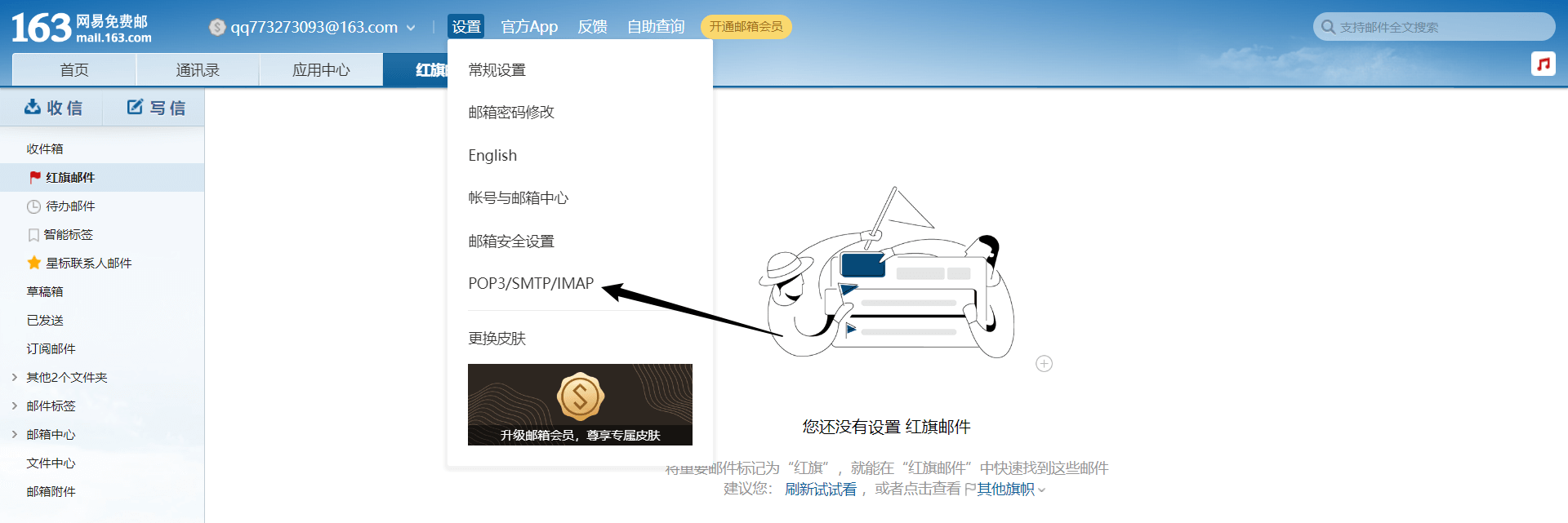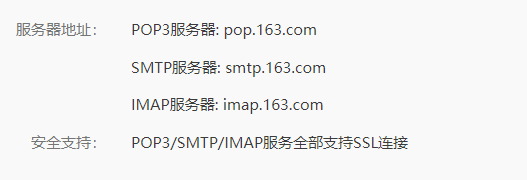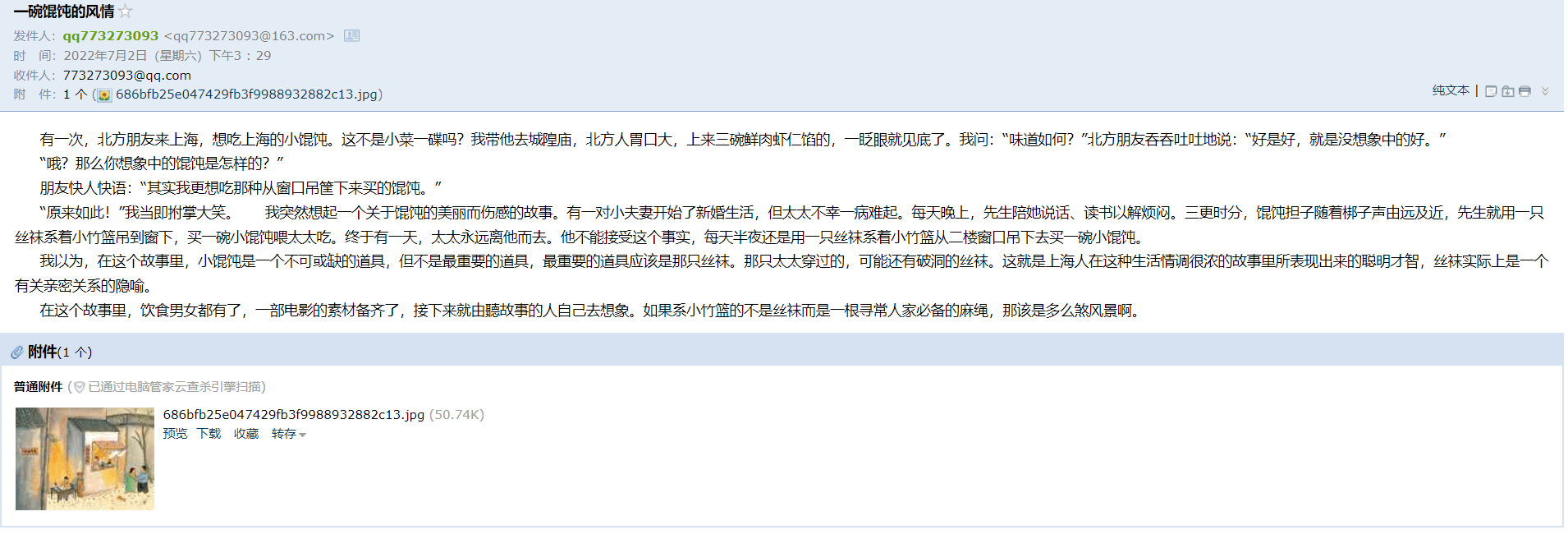邮箱推送是什么? 见名知意,就是通过邮箱来推送消息到另一个邮箱。因为微信公众号推送测试号的提醒貌似以及不再提醒了(不排除是手机系统问题),所以想着回归最淳朴的邮件推送。邮件推送主要用户发送定时执行的网络爬虫产生的数据,数据展示爬虫的运行情况,例如是否成功签到等等。
有什么意义呢? 意义嘛,看个人怎么应用罢了,我罗列一下我的应用场景吧。
Python 自动签到结果反馈 Python 爬虫出错提醒(大量、长时间的爬取数据) 程序执行结果反馈(大学毕设选题使用的 Python 自动抢课题,把抢到的课题反馈到邮箱) 实时监控数据变化(奥运会得奖牌通知并播报) ………… 说真的,应用场景很多很多好吧,只要是你想让程序通知你知道的情况都可以使用邮箱推送。人可能会忘了一件事没来得及通知你,但程序不会,只要条件符合,它就会触发并且通知你。
实现原理是什么? 其实就是登录邮箱并且使用该邮箱给指定的邮箱发邮件,就这么简单,只是把平时人工操作的步骤交给代码来执行了罢了。
准备邮箱 首先需要准备一个邮箱用来发送邮件,并且为邮箱开通 IMAP/SMTP 登录功能
在开启 IMAP/SMTP 登录功能后,需要为邮箱添加一个登录授权码,相当于邮箱的密码。
在获取到授权码后,需要查看该邮箱的 SMTP 服务器地址,例如网易的 163 邮箱为 smtp.163.com
代码实现 Python 版本 1 2 3 4 5 6 7 8 9 10 11 12 13 14 15 16 17 18 19 20 21 22 23 24 25 26 27 28 29 30 31 32 33 34 35 36 37 38 39 40 41 42 43 44 45 46 47 48 import datetimeimport uuidimport osfrom email.header import Headerfrom email.mime.application import MIMEApplicationfrom email.mime.multipart import MIMEMultipartfrom email.mime.text import MIMETextfrom smtplib import SMTP_SSLhost_server = '你的SMTP服务器地址' sender = '用来发送邮件的邮箱' pwd = '发送邮件的邮箱授权码' receiver = '需要接收邮件的邮箱地址' def run (mail_title, mail_content, mail_file_path ): try : msg = MIMEMultipart() msg["Subject" ] = Header(mail_title, 'utf-8' ) msg["From" ] = sender msg["To" ] = Header(receiver, 'utf-8' ) msg.attach(MIMEText(mail_content, 'plain' , 'utf-8' )) for filenames in mail_file_path: if os.path.exists(filenames): file = MIMEApplication(open (filenames, 'rb' ).read()) filename = str (uuid.uuid4()).replace('-' , '' ) + os.path.splitext(filenames)[-1 ] file.add_header('Content-Disposition' , 'attachment' , filename=filename) msg.attach(file) smtp = SMTP_SSL(host_server) smtp.login(sender, pwd) smtp.sendmail(sender, receiver, msg.as_string()) smtp.quit() except Exception as e: print (e, datetime.datetime.now()) if __name__ == '__main__' : file_path = ["C:/img/1.jpg" , "C:/img/2.jpg" , "C:/img/3.jpg" ] title = "这是标题" content = "这是正文" run(title, content, file_path)
Java 版本 Maven 依赖 1 2 3 4 5 <dependency > <groupId > javax.mail</groupId > <artifactId > mail</artifactId > <version > 1.4.7</version > </dependency >
代码实现 1 2 3 4 5 6 7 8 9 10 11 12 13 14 15 16 17 18 19 20 21 22 23 24 25 26 27 28 29 30 31 32 33 34 35 36 37 38 39 40 41 42 43 44 45 46 47 48 49 50 51 52 53 54 55 56 57 58 59 60 61 62 63 64 65 66 67 68 69 70 71 72 73 74 75 76 77 78 79 80 81 82 83 84 85 86 87 88 89 90 91 92 93 94 95 96 97 98 99 100 101 102 103 104 105 106 107 108 109 110 111 112 113 114 115 116 117 118 public class sendEmailUtils { private final static String PROTOCOL = "smtp" ; private final static String HOST = "smtp.163.com" ; private final static String PORT = "25" ; private final static String IS_AUTH = "true" ; private final static String IS_ENABLED_DEBUG_MOD = "true" ; private final static String AUTHORIZATION_CODE = "发送邮箱的授权码" ; private static final String from = "发送邮件的邮箱" ; private static final String to = "接收邮件的邮箱" ; private static final Properties props; private static Transport transport = null ; static { props = new Properties (); props.setProperty("mail.transport.protocol" , PROTOCOL); props.setProperty("mail.smtp.host" , HOST); props.setProperty("mail.smtp.port" , PORT); props.setProperty("mail.smtp.auth" , IS_AUTH); props.setProperty("mail.debug" ,IS_ENABLED_DEBUG_MOD); Session session = Session.getInstance(props, new MyAuthenticator ()); try { transport = session.getTransport(); transport.connect(from, AUTHORIZATION_CODE); } catch (MessagingException e) { e.printStackTrace(); } } public static void sendTextEmail (String to, String title, String content, List<String> filePathList) { try { Session session1 = Session.getInstance(props, new MyAuthenticator ()); MimeMessage message = new MimeMessage (session1); message.setFrom(new InternetAddress (from)); message.setSubject(title); message.setRecipient(RecipientType.TO, new InternetAddress (to)); message.setSentDate(new Date ()); message.setText(content); MimeMultipart mailContent = new MimeMultipart ("mixed" ); message.setContent(mailContent); if (!filePathList.isEmpty()){ for (int i = 0 ; i < filePathList.size(); i++) { MimeBodyPart mimeBodyPart = new MimeBodyPart (); mailContent.addBodyPart(mimeBodyPart); FileDataSource source = new FileDataSource (filePathList.get(i)); DataHandler dataHandler = new DataHandler (source); String uuid = UUID.randomUUID().toString().replace("-" , "" ); mimeBodyPart.setFileName(uuid+ source.getName().lastIndexOf("." )); mimeBodyPart.setDataHandler(dataHandler); } } message.saveChanges(); transport.sendMessage(message, message.getAllRecipients()); transport.close(); } catch (Exception e) { e.printStackTrace(); } } static class MyAuthenticator extends Authenticator { public MyAuthenticator () { super (); } @Override protected PasswordAuthentication getPasswordAuthentication () { return new PasswordAuthentication (from, AUTHORIZATION_CODE); } } public static void main (String[] args) { ArrayList<String> arrayList = new ArrayList <>(); arrayList.add("C:\\img\\1.jpg" ); arrayList.add("C:\\img\\1.jpg" ); arrayList.add("C:\\img\\1.jpg" ); sendTextEmail(to,"1" ,"2" , arrayList); } }
效果展示




